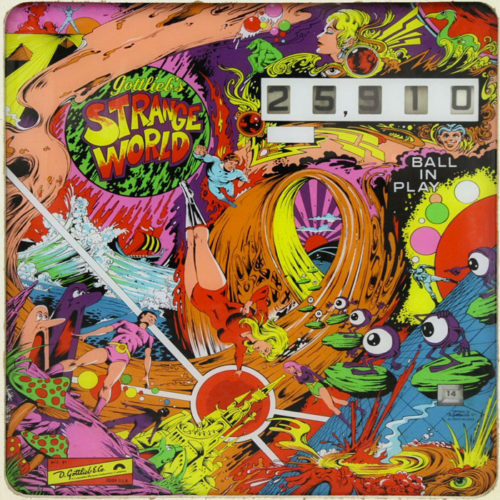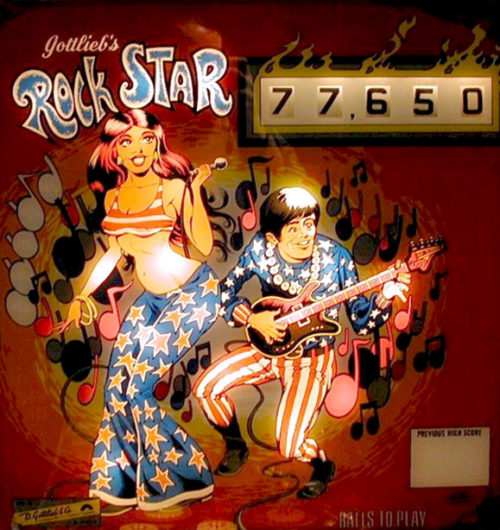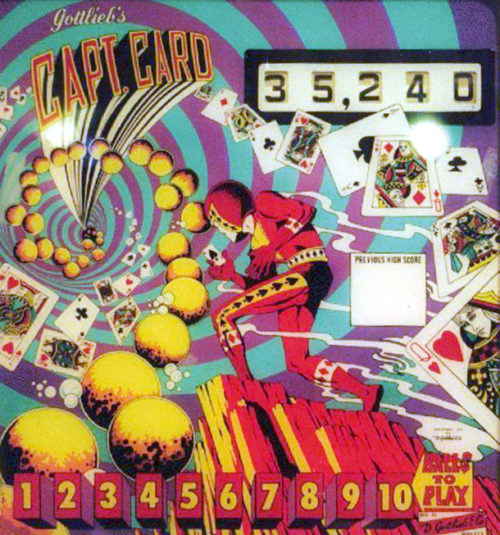-

-
 Gottlieb produced a few baseball-themed games, but Williams Manufacturing was the king of these types of games. This game, designed by Ed Krynski with art by Gordon Morison, had a run of 775 units. This is the add-a-ball version of this game, so it is rarer. The replay version is called Grand Slam. This game has eject holes which activate the roto-target, a Gottlieb exclusive device, which stops and a man is lit on a corresponding base to the eject hole on the baseball diamond. The rollover button lights when the bases are loaded. This scores 1,000 points whenever the bases are loaded. Runs and score are the ways to win free balls with this game.
Gottlieb produced a few baseball-themed games, but Williams Manufacturing was the king of these types of games. This game, designed by Ed Krynski with art by Gordon Morison, had a run of 775 units. This is the add-a-ball version of this game, so it is rarer. The replay version is called Grand Slam. This game has eject holes which activate the roto-target, a Gottlieb exclusive device, which stops and a man is lit on a corresponding base to the eject hole on the baseball diamond. The rollover button lights when the bases are loaded. This scores 1,000 points whenever the bases are loaded. Runs and score are the ways to win free balls with this game. -

-
 The game before you is extremely rare with only 278 screwed together at the Chicago Gottlieb factory. This one-player electromechanical add-a-ball game was designed by John Osbourne with art by Gordon Morison. A replay version was also designed by the name of Blue Note. The object of this machine is to complete all the notes down the left side of the playfield. Doing so activates the classic “wow” feature which, when hit, awards one free ball. A reset is in your future once your current ball drains. Score is another way to achieve longer play by winning extra balls. The spinner in the middle of the playfield awards big points when 1,000 points is lit; each spin of the target awards 1,000 points plus number of revolutions spun. A nice retro art package completes this rare machine.
The game before you is extremely rare with only 278 screwed together at the Chicago Gottlieb factory. This one-player electromechanical add-a-ball game was designed by John Osbourne with art by Gordon Morison. A replay version was also designed by the name of Blue Note. The object of this machine is to complete all the notes down the left side of the playfield. Doing so activates the classic “wow” feature which, when hit, awards one free ball. A reset is in your future once your current ball drains. Score is another way to achieve longer play by winning extra balls. The spinner in the middle of the playfield awards big points when 1,000 points is lit; each spin of the target awards 1,000 points plus number of revolutions spun. A nice retro art package completes this rare machine. -
 October was the birthdate for this machine. It was designed by Ed Krynski with artwork by Art Stenholm. Low production run of 550 units. This is an add-a-ball game, the replay version being called Sing Along. This game was a variation on a classic Gottlieb game Kings and Queens, in that it contains the four side-by-side kickout holes made popular in 1965. Here, the object of the game is to complete four same-colored numbers vertically in a row to randomly cause the kickout hole to light to score an extra ball if you land in the hole when it’s lit. If you didn’t win a ball, each light in the column would award 10 points. If you have most of the lights lit, a run at the kickout holes awards a lot of points in a hurry which, in this game, also awards extra balls. One center target is also incorporated into the game, awarding 100 points when hit and lights the pop bumpers for higher scoring.
October was the birthdate for this machine. It was designed by Ed Krynski with artwork by Art Stenholm. Low production run of 550 units. This is an add-a-ball game, the replay version being called Sing Along. This game was a variation on a classic Gottlieb game Kings and Queens, in that it contains the four side-by-side kickout holes made popular in 1965. Here, the object of the game is to complete four same-colored numbers vertically in a row to randomly cause the kickout hole to light to score an extra ball if you land in the hole when it’s lit. If you didn’t win a ball, each light in the column would award 10 points. If you have most of the lights lit, a run at the kickout holes awards a lot of points in a hurry which, in this game, also awards extra balls. One center target is also incorporated into the game, awarding 100 points when hit and lights the pop bumpers for higher scoring. -
 May was the release month for this game. Designer Ed Krynski and artist Gordon Morison put together the package. Production run was low, at 675 units. This is an add-a-ball game variant, the replay version was called High Hand. The challenging part of this playfield design is trying to lock a ball in the eject hole for extra balls. Four batteries of drop targets in four colors are along the sides of the playfield. Making a completion of a color of drop targets increases the value of the eject and side drains. If all the drop targets are completed, the extra ball features light up. Score is another way to win balls set by the operator. No match units were incorporated into these games as, again, that was considered a form of gambling, i.e. winning a free game.
May was the release month for this game. Designer Ed Krynski and artist Gordon Morison put together the package. Production run was low, at 675 units. This is an add-a-ball game variant, the replay version was called High Hand. The challenging part of this playfield design is trying to lock a ball in the eject hole for extra balls. Four batteries of drop targets in four colors are along the sides of the playfield. Making a completion of a color of drop targets increases the value of the eject and side drains. If all the drop targets are completed, the extra ball features light up. Score is another way to win balls set by the operator. No match units were incorporated into these games as, again, that was considered a form of gambling, i.e. winning a free game. -
